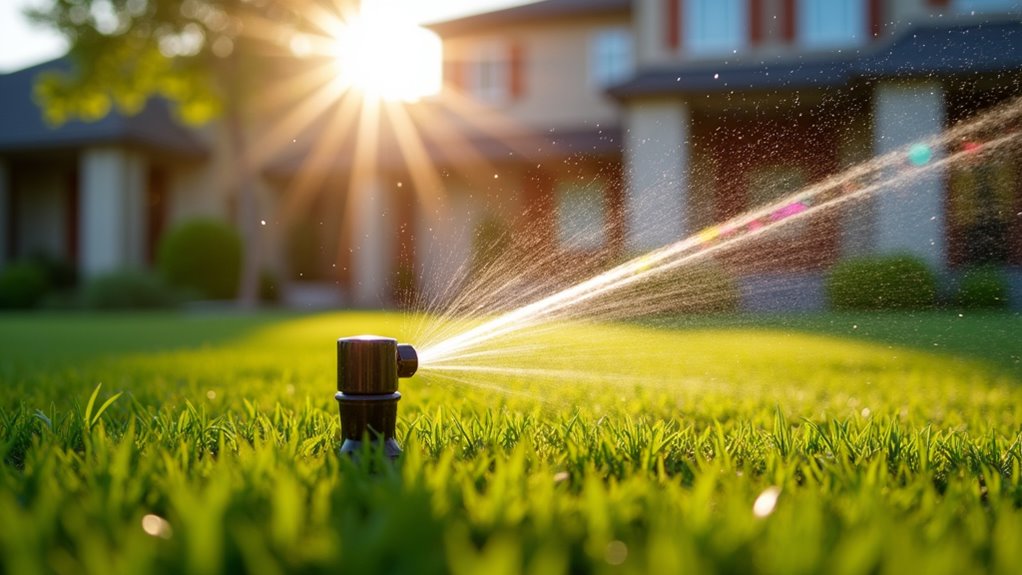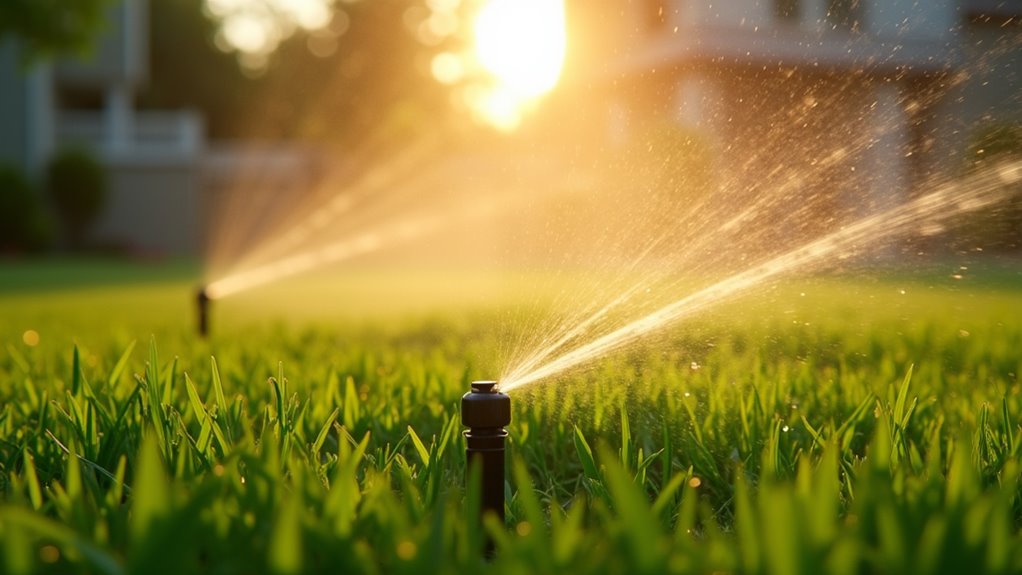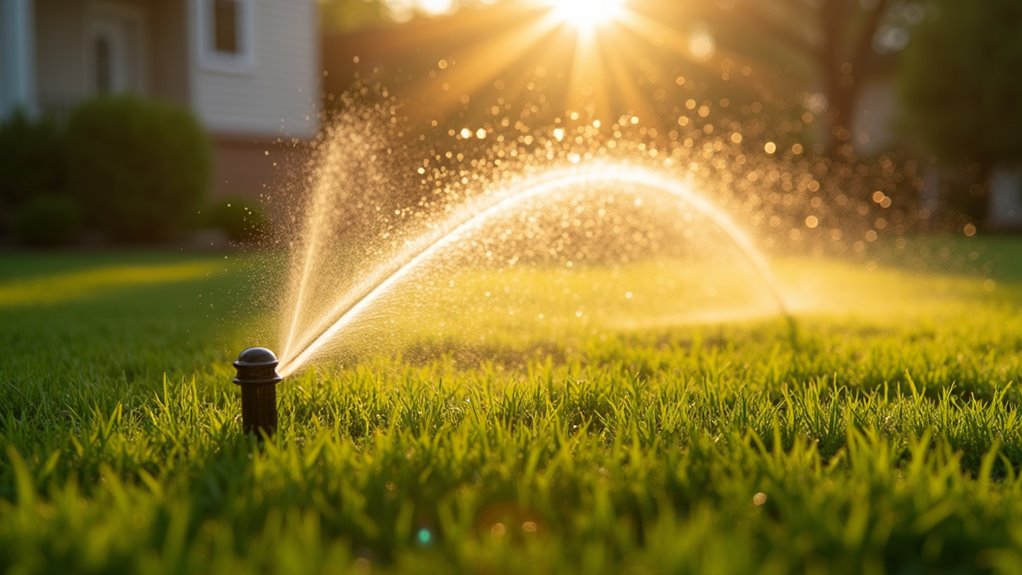Water your lawn in early morning hours (before 10 a.m.) or early evening (4-6 p.m.) for maximum absorption and disease prevention. You’ll need 1-1.5 inches of water weekly, combining rainfall and irrigation. Check for signs like persistent footprints or grayish color to determine if your grass needs water. Adjust your watering schedule based on your grass type, soil conditions, and local climate. Understanding these fundamentals will help you develop an efficient irrigation strategy.
Best Times to Water for Maximum Absorption

The two most effective times to water your lawn occur during the early morning hours before 10 a.m. and in the early evening between 4-6 p.m. During early morning hours, you’ll achieve maximum absorption since evaporation rates are at their lowest, allowing water to penetrate deeply into the soil and reach the grass roots.
If you need to run your sprinkler in the evening, aim for 4-6 p.m. This timing gives grass blades enough time to dry before nightfall, reducing the risk of fungal diseases while maintaining soil moisture throughout the night. Don’t water during afternoon hours, as high temperatures and wind will cause excessive evaporation and waste water. By adjusting your watering time based on your local climate, you’ll promote stronger root growth and maintain a healthier lawn throughout the week.
Essential Weekly Water Requirements
Knowing when to water your lawn is only part of maintaining healthy grass – understanding proper water quantities secures ideal growth. Your lawn needs 1-1.5 inches of water per week, combining both rainfall and irrigation, to stay healthy.
You’ll want to water deeply in one session or split into two separate waterings, allowing the soil to absorb moisture thoroughly. To determine your specific watering duration, calculate your sprinkler’s flow rate and your lawn’s square footage. Place empty cans across your grass to measure water distribution and adjust your timing accordingly.
Watch for signs of overwatering – if you notice puddles or soggy soil, reduce your watering frequency. This measured approach certifies your grass receives exactly what it needs without waste, promoting strong root development and sustainable lawn health.
Signs Your Lawn Needs Watering
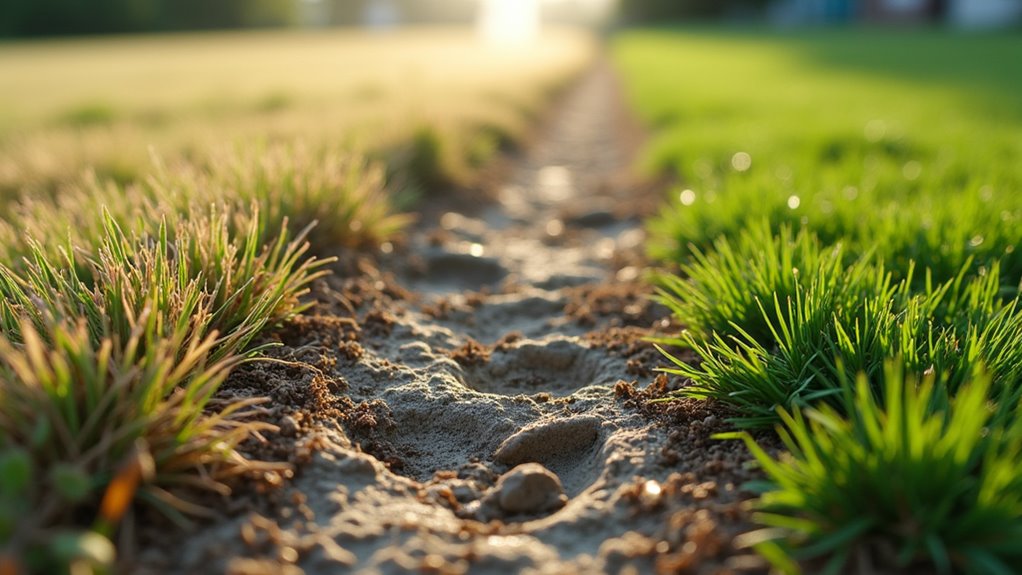
If you notice footprints remaining visible on your lawn after walking across it, your grass isn’t bouncing back due to insufficient water. You’ll also spot a telltale grayish or dull green color when your lawn is thirsty, rather than the vibrant green of well-hydrated grass. Check your lawn early in the morning by walking across it – persistent footprints and a grayish tone are clear signals it’s time to water.
Walking Test Shows Thirst
When grass blades lose their resiliency due to insufficient moisture, your lawn will reveal clear distress signals through a simple walking test. As you walk across your grass, pay attention to how the blades respond to your footsteps. If your footprints remain visible in the lawn for an extended period rather than springing back quickly, it’s a clear indication your lawn needs water.
You’ll also notice the lawn appear less vibrant when it’s thirsty. A healthy, well-hydrated lawn maintains a bright green color, while a water-stressed lawn will display a dull, grayish-green hue. This color change, combined with persistent footprints in the soil, serves as a reliable indicator that it’s time to water. By regularly performing this walking test, you can guarantee your lawn remains resilient and properly hydrated.
Grayish Color Indicates Need
Your lawn’s color serves as a vital indicator of its hydration needs. When your lawn’s appearance takes on a grayish cast or appears dull green, it’s telling you it needs water. This color change, combined with visible footprints on the lawn that don’t quickly disappear, confirms your lawn needs to be watered.
While lawns are resilient and can adapt to differing conditions, understanding these visual cues helps you provide water at the appropriate time. The time to dry after walking on grass varies depending on soil type, with clay soils retaining moisture longer than sandy ones. Before hastening to water, bear in mind that established lawns can naturally go dormant during dry spells – it’s their way of conserving resources until Mother Nature provides relief through rainfall.
Check Early Morning Footprints
Early morning footprints offer a reliable test to determine your lawn’s hydration needs. Watering in the morning gives you the best opportunity to assess your lawn’s moisture level, helping you decide if it’s time to water your lawn. When footprints remain visible in the grass, it’s a clear indication that the top soil lacks adequate moisture for healthy growth.
- If footprints don’t quickly disappear, your lawn needs water to maintain a deep root system
- Check how much the grass springs back after walking across it – slow recovery means it’s time to water
- A grayish or dull green appearance, combined with lasting footprints, confirms your lawn requires immediate watering
This simple footprint test, performed at the best time to water, helps you measure how much water per week your lawn truly needs.
Measuring Water Application Methods
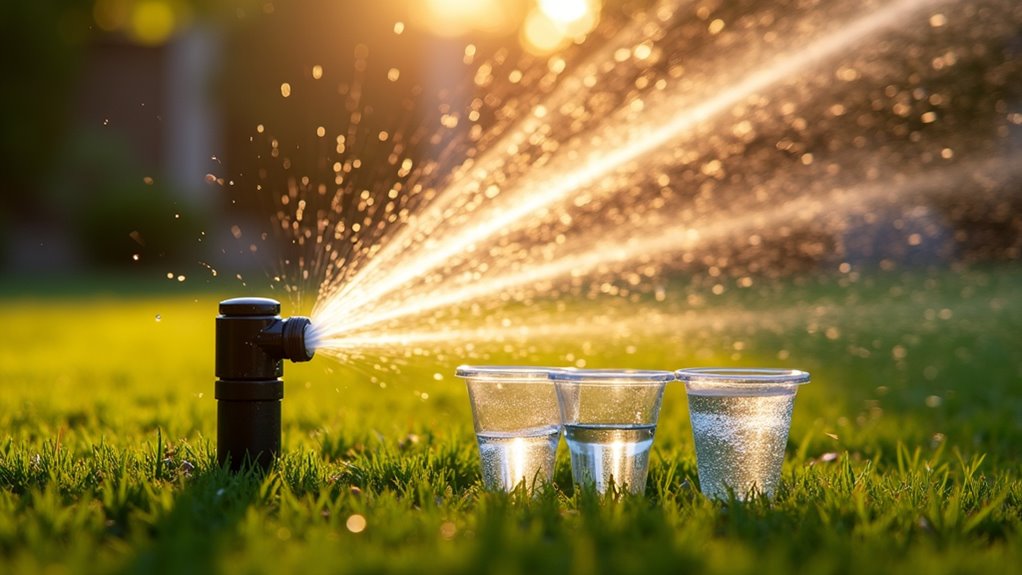
Measuring the amount of water your lawn receives is essential for efficient irrigation and healthy grass growth. You can place straight-sided cans across your lawn areas to track how evenly your sprinkler system delivers water. To achieve the recommended 1-1.5 inch of water per week, calculate your lawn’s square footage and your sprinkler’s flow rate to determine the time it takes to reach this goal.
Connect a flow timer to your system to precisely monitor water usage. To guarantee water penetrates deeper into the soil, divide your total watering time into shorter cycles, especially on slopes or compacted areas. You’ll know you’ve applied enough water when you can easily push a probe 6 inches into the soil consistently moist. This methodical approach helps you run your sprinkler efficiently while maintaining ideal lawn hydration.
Adjusting Water Needs by Grass Type
Understanding grass species characteristics helps determine precise watering schedules. To properly water your lawn, you’ll need to adjust irrigation based on whether you have cool-season or warm-season grass varieties. Warm-season grasses like zoysia and bermuda need less water because they encourage the grass roots to grow deeper, while cool-season varieties like Kentucky bluegrass typically require more frequent watering.
- Water cool-season grasses twice per week to prevent shallow root development
- Make sure new lawns receive consistent moisture during the initial year
- Adjust watering frequency based on soil type, with clay soils needing less frequent irrigation than sandy soils
Some varieties, like tall fescue, can survive long periods without water by going dormant during drought conditions. Your lawn’s needs will vary extensively depending on grass type and local soil conditions.
Smart Sprinkler Techniques and Coverage
To optimize your lawn’s health while conserving water, smart sprinkler systems and proper coverage techniques play a vital role in efficient irrigation. These advanced systems use weather data and soil moisture sensors to automatically adjust watering schedules, preventing wasteful over-watering.
You’ll find in-ground sprinklers provide the most efficient solution, delivering water in overlapping patterns for even coverage. For smaller lawns, hose-end sprinklers work well but require more manual adjustments. If you’re looking to cover larger areas with fewer heads, consider pulsating sprinklers, which distribute water horizontally at high velocity.
To measure your sprinkler output accurately, place straight-sided cans across your lawn. This simple test helps you determine the runtime needed to achieve the recommended one inch of weekly water, ensuring precise irrigation management.
Seasonal Watering Adjustments
While proper sprinkler coverage forms the foundation of lawn care, your watering schedule must adapt throughout the year. How often you water your lawn depends on seasonal demands. In spring, early watering helps grass roots to grow strong as the lawn emerges from dormancy. Summer’s heat requires more frequent watering to prevent stress, though watering less often but deeply encourages stronger root development.
- Fall requires 2.5 cm of water weekly until freeze, plus overseeding to establish a healthy lawn
- Winter means pausing irrigation once the ground freezes
- Spring and summer need two or three deep waterings per week instead of daily light sprinklings that encourages shallow roots
Remember to mist the seeded area in fall, ensuring every drop counts while protecting grass blades from seasonal stressors.
Frequently Asked Questions
How Do I Properly Water My Lawn?
You’ll want to water your lawn early morning when dew absorption is highest, typically before 10 a.m. Set your automatic sprinkler system or use manual watering techniques to deliver 1-1.5 inches weekly. Monitor soil moisture levels and lawn health indicators to adjust your irrigation schedule. Practice water conservation by dividing watering into shorter sessions, allowing proper soil absorption. Your lawn maintenance routine should include checking for even water distribution and adjusting based on soil type.
What Is the General Rule of Thumb for Watering Your Lawn?
You’ll want to provide your lawn with 1-1.5 inches of water weekly, adjusting for weather conditions and soil moisture levels. Water early morning (before 10 a.m.) when water pressure is ideal and evaporation is minimal. Choose appropriate sprinkler types based on your lawn area size, and monitor water runoff to prevent waste. Set up irrigation systems to run 2-3 times per week for better water conservation. Adjust watering frequency during rainy periods or drought restrictions.
Is 10 Minutes Long Enough to Water Grass?
No, 10 minutes isn’t long enough for effective lawn watering. You’ll want to water deeply for 30-60 minutes, 2-3 times per week, rather than daily shallow watering. Whether you’re using automated sprinklers or manual hose watering, you should aim to soak the soil 6-8 inches deep. Early morning watering is ideal, while avoiding afternoon watering due to evaporation. Monitor soil moisture and make weather-based adjustments to prevent overwatering concerns and promote healthy root growth.

